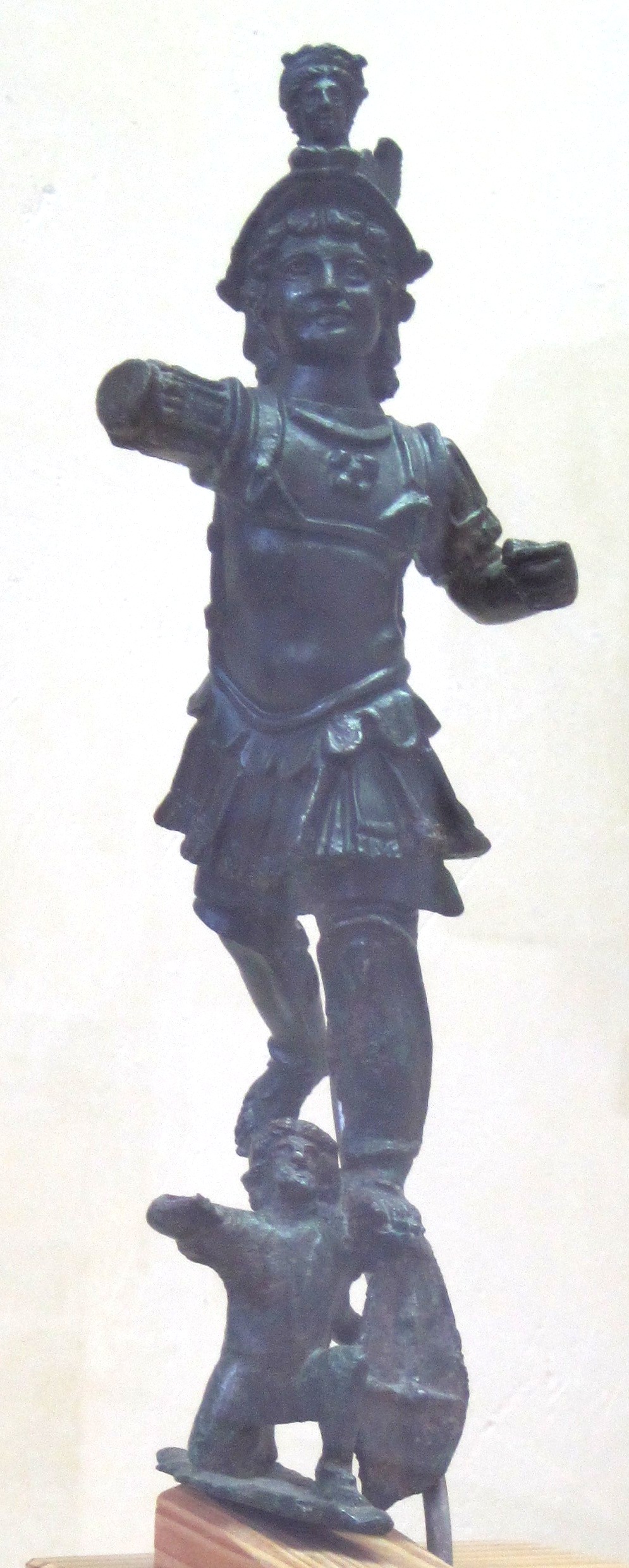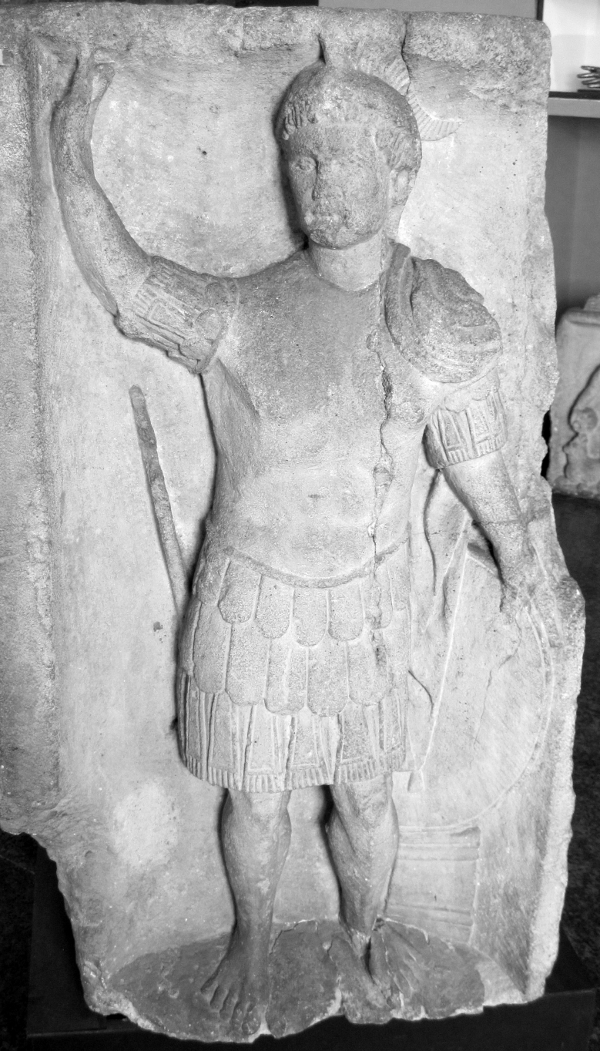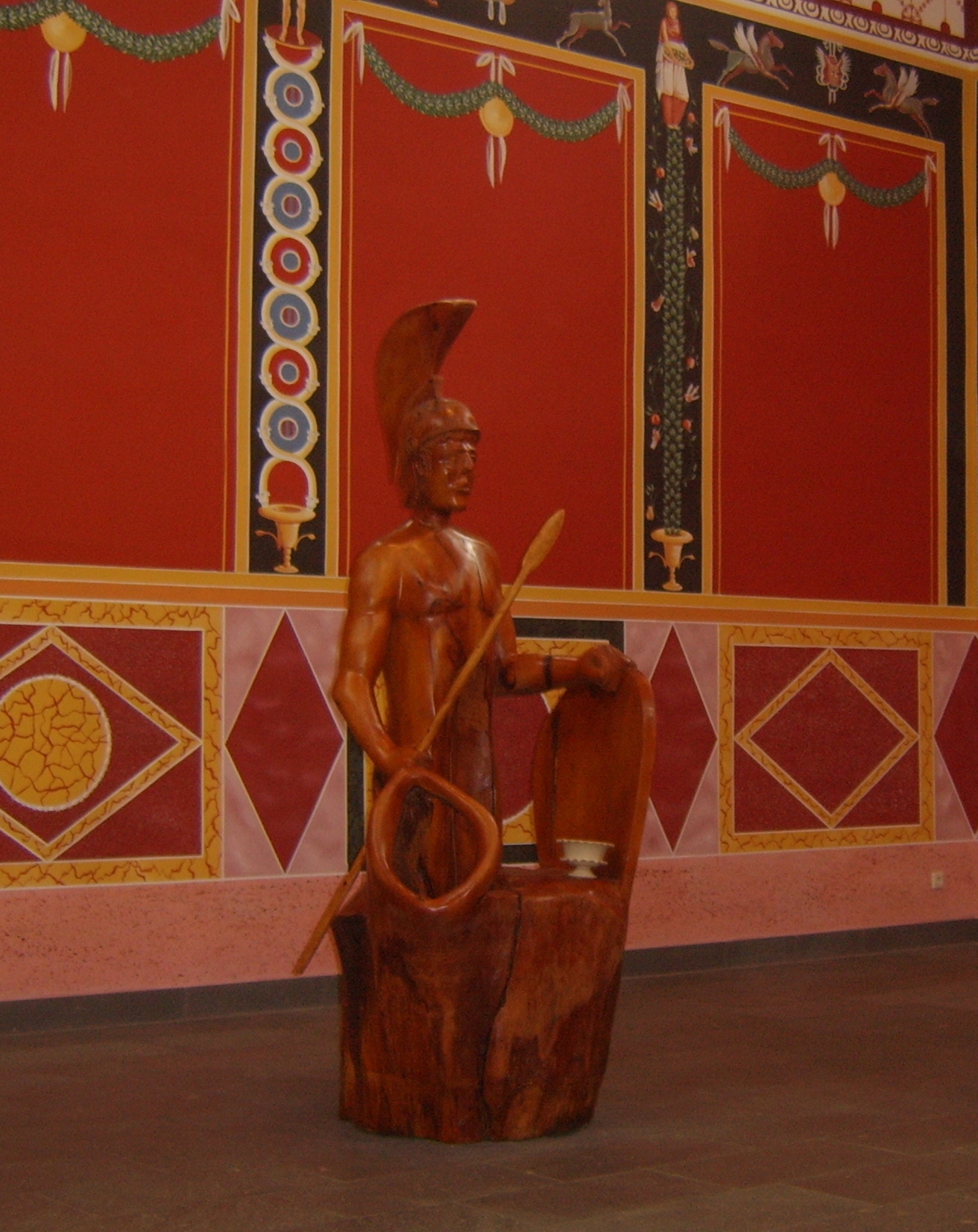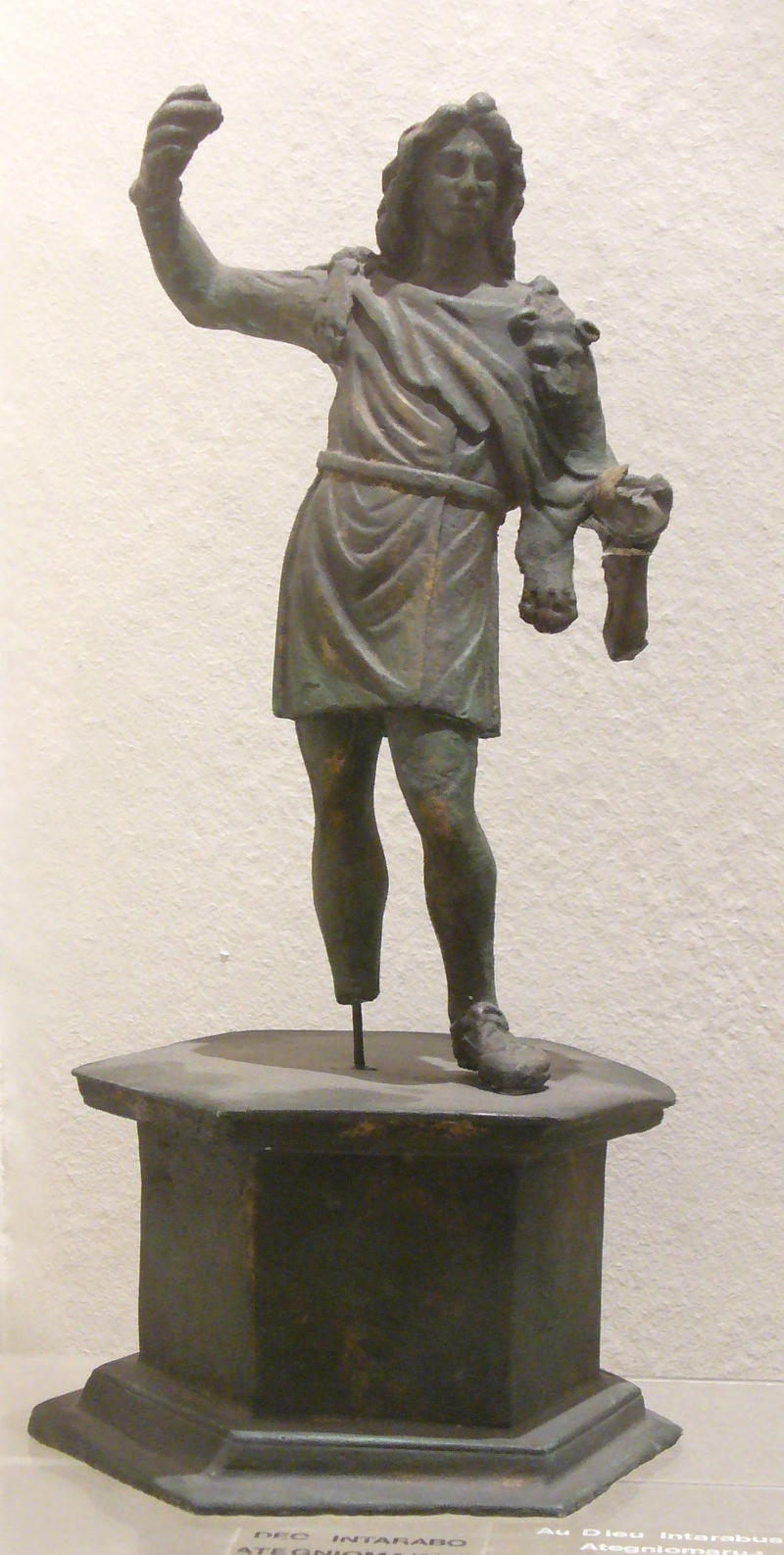
An armed Mars striking down an enemy: bronze statuette from the territory of the Remi.
(Musée Saint-Remi, Reims)
Regional Diversity · Among the Treveri (Lenus, Jovantucarus, Loucetius, Intarabus, others)
“Mars presides over wars. To him, when they have determined to engage in battle, they commonly vow those things which they shall take in war. When they have conquered, they sacrifice whatever captured animals may have survived the conflict, and collect the other things into one place. In many states you may see piles of these things heaped up in their consecrated spots; nor does it often happen that any one, disregarding the sanctity of the case, dares either to secrete in his house things captured, or take away those deposited; and the most severe punishment, with torture, has been established for such a deed.”
—Julius Cæsar (summarizing Posidonius)[1]

The warlike god par excellence, Mars’ role is by no means limited to this function. Although the patron of bloody combat, he can also heal the sick. Like Silvanus, he is committed to protecting the fields. Mars is also charged with preserving the institutions of local self-government—the old tribal units integrated into the Roman system as ciuitates. This son of Jupiter and Juno became the father of Romulus and was cherished by soldiers in service to Rome. At the same time, he is known by more Celtic names than any other deity.[2]
A single foundation underlies all of these apparently disparate elements, and it is not war, despite what Posidonius says.[3] Rather, it is the function of protecting that unites the various elements we find in the Gallo-Roman Mars. He protects soldiers engaged on the battlefield. He protects the sick against their maladies. He protects farmland, property, and the integrity of the tribe. If, in order to protect, he must fight, then Mars is ready; but this is not his priority. (Here is a strong point of contrast with the Greek Ares, whom the other Olympians reproach for stoking violence willy-nilly.)
This divine protector of the tribe is linked, as might be supposed, to distinctive characteristics of each tribe. The Mars of the Sequani is not obviously that of the Bellovaci. Hence the profusion of tribal names and epithets. It has been speculated—and on good grounds—that Mars covers the same function as Toutatis (which Lucan spells “Teutates”), that is the tribal protector god (the name, deriving from *toutā, contains the same root as tuath ‘tribe’ in Irish) ... or rather even the toutates, if we understand each tribe to have its own.[4]
The various avatars of Mars are often found in the company of a range of goddesses: we find Lenus Mars and Ancamna among the Treveri, Mars Loucetius and Nemetona at Mainz, Mars Cicolluis and Litavis, and others. In more Romanized areas, Mars is not without a companion, though she may instead be called Victoria or sometimes Bellona. These goddesses were what is called the god’s paredros, his companion whose power was the reflection of his own. It is only rarely that we find Mars with Venus, his divine lover in Greek and Roman mythology.
The representation of Mars most often follows Græco-Roman norms. He wears a giant-crested Corinthian helmet and armour. He can carry a spear, a sword, a shield, or all three. Still, certain variations exist. Mars is sometimes nude, and, particularly in early depictions, sometimes bearded. Among the animals sacred to him are the wolf and the woodpecker. Besides these animals, horses were also sacrificed to him.

In certain regions, inscriptions to Mars are more numerous than those to Mercury. This is the case for instance in Gallia Narbonensis and Britain.
The list below enumerates the native epithets of Mars known from Gaul so far, followed by the name of the tribe among whom the inscriptions were found, and how many of them there were.[2]
The asterisk (*) designates a name that is clearly non-Celtic or found outside the Gaulish language area (whether in Aquitania or in Germania Inferior). Chief among these are Mars Leherennus and Mars Sutuigus, both of whom were worshipped among the Convenæ in the foothills of the Pyrenees.
There is a concentration of theonyms in Gallia Belgica and the adjacent portion of Germania Superior (partly due to a stronger epigraphic habit in these regions). In the section on the Treveri below, we shall consider in greater detail the cases of Lenus Mars, Intarabus, Mars Loucetius, Mars Camulus, Mars Cicolluis and Mars Cnabetius. In the meantime, we should add a few words on certain other major forms of Mars.
Mars Mullo is known through a significant number of inscriptions in the northwest of Gaul—in precisely one of the areas where inscriptions overall are rarest. Mars Mullo, indeed, has an extraordinary status. He has been interpreted as the divine protector of several places and tribes in Armorica (roughly present-day Brittany), notably the Riedones (the people around Rennes).
Mars Albiorigius can be found in the Alpine regions of Provence and Dauphiné. His name can be interpreted in Gaulish to mean ‘of the white king’. Is this to be connected with the snowy mountains of the region? The very word ‘Alps’ is thought to derive from the same Celtic root....[5]
Mars ‘Caturix’ is equally easy to interpet: the epithet means simply ‘battle-king’ (although since the Gaulish rīx has a broad range of meanings, we might more prudently render it as ‘battle-chief’). Mars Caturix is found essentially among the Helvetii.
The epithet of Mars Segomo has been translated as ‘Victor’,[6] which, after all, would certainly make sense. All the same, it is rather curious that Mars Segomo is only found in quite a limited area: essentially Burgundy, Lyon and Franche-Comté. This word is only found in a religious context one other time—on a dedication to Segomo Cuntinus at Nice (the inscription does not specifically name Mars...).
Unlike Mercury or Jupiter Optimus Maximus, Mars is most often invoked under a Celtic name among the Treveri. More surprisingly still, the Celtic name Lenus precedes the Roman name in most cases. This name has been translated as “wood, grove”,[7] which should perhaps be understood as referring to the Ardennes, that “immense forest,” in Cæsar’s description, “that crosses Treveran territory and stretches from the Rhine to the land of the Remi”, and where the rebel chief Indutiomarus was able to hide “all those whose age prevented them from bearing arms”.[8] As an essential element of Treveran topography and a defensive feature par excellence, the Ardennes might well have given its identity to the Mars of the Treveri, as indeed it had to the goddess Arduenna and perhaps to the god Intarabus (god between Meuse and Rhine...).
All of the most widespread Celtic epithets of Gallia Belgica are also attested in Treveran territory (Cicolluis, Camulus, Loucetius and Cnabetius). This must, in part, be due to the commercial, demographic and cultural importance of the city of Augusta Treverorum (today’s Trier), which therefore attracted residents from other tribal areas. It might also derive from a common Belgic patrimony. Beyond these forms of Mars, typical of the region, several others deserve to be noted which were specific to the Treveri: Mars Jovantucarus, protector of the young; Mars Smertulitanus, the provider; and Mars Vegnius. On the surface, this represents rather remarkable diversity within a single ciuitas. For his worshippers among the Treveri, then, was there a single Mars, or several? As we shall see, there is reason to think that some of these names merely refer to the main (Lenus) Mars. Others have quite an independent identity.

Lenus Mars is thought to be the patron god of the Treveran tribe. A spring located on a slope facing Trier is attributed to him; it is reputed to have healing properties. The classical temple built on the site (called Am Irminenwingert) was imposing in size and situation.[9a] Another sanctuary was found on the Martberg (‘hill of Mars’) downriver on the Moselle, where an altar is dedicated “in h. d. d. deo Marti Laeno”.[10] Here, too, the curing element is dominant—which does not prevent Mars from appearing as a warrior, helmeted and naked. Mars heals people by combatting their ailments. In recognition for his healing work, Lenus Mars received such offerings as altars, statuettes and coins. At the sanctuary Am Irminenwingert, many such statues depicted genii cucullati in the form of hooded dwarves.[9b]
The paredros of Lenus Mars is a goddess named Ancamna (they are invoked twice under these exact names). Two more inscriptions invoke Mars and Ancamna, without the name Lenus, but it is a safe inference that the god in question is the same. (It would be rather bizarre, in fact, if two Gaulish deities took the same Roman name and the same consort without being assimilated.) In the sanctuary near Möhn, there is an inscription Marti Sme[rtuli]t[a]no et [Anc]amnae.[11] If the text is correctly reconstructed, this inscription provides evidence for identifying Mars Smertulitanus and Lenus Mars—namely, Ancamna herself. On these grounds, Smertulitanus can be counted as an epithet of our (Lenus) Mars, along with Exsobinius(?) and Arterancus(?) which appear on inscriptions dedicated Leno Marti Exsobin at Saint-Mard[12] and [In h. d.] d. Leno Marii Arte/[...]co at Fließem.[13] After all, the Greeks and Romans themselves used a variety of names for the same gods—Apollo is Phœbus, Diana is Phœbe, Minerva is Pallas, Mercury is Argiphontes—not to speak of patronymics and geographic epithets. How, then, exactly were Lenus Mars and Ancamna linked? It is normally thought that Ancamna was the wife of Lenus Mars in these parts. She could hardly have been his mother, for Juno has a prominent place among the Treveri and was never presented similarly to Ancamna.
An interesting variation is revealed by two inscriptions invoking, respectively, Lenus Mars and Victoria, and then Mars and Victoria. These inscriptions appear to establish that the divine companion of (Lenus) Mars was most often called Ancamna, but that her name was sometimes Romanized as Victoria.
I would suggest yet another identity for this same couple: Veraudunus and Inciona. An inscription from Luxembourg invokes [Le]no Mar[ti. ...] Veraudune[......]Incione;[14] another is instead in h. d. d. deo Verauduno et Incionae.[15] If this identification is accepted (which depends on the reading of the former inscription), this would be a very localized form of the great Treveran couple. The epithet Veraudunus may be purely geographical, for an adjacent hill—the Widdebierg—is thought to derive from the same root (as Virton and Verdun may as well...).[9c]
In the 5 inscriptions that mention him, Mars Jovantucarus is invoked alone. Still, one of the contexts of these invocations is the sanctuary of Lenus Mars. On account of his sobriquet (‘one who cares for the young’) and ex votos representing children, Mars Jovantucarus has been taken to be a guardian of the young, invoked for the healing of childhood diseases. This Jovantucarus should have been at least somewhat autonomous with respect to (Lenus) Mars, since he is linked on one occasion with Mercury rather than with Mars. The votive statues dedicated to Mars Jovantucarus include children carrying doves.[16]
The final members of Lenus Mars’ entourage are the Xulsigiæ. These are goddesses involved in healing at the spring of Lenus Mars. The only inscription we have[17] forbids us to say more. They may have been local nymphs. (Both the pronunciation and the etymology of their name are obscure; this is the only initial x- known in Gaulish.)
Next we consider Mars Loucetius, found in three Treveran inscriptions—two of which were left outside tribal territory by expatriated Treveri. One of these invokes Loucetius Mars and Nemetona, another Mars Loucetius and Victoria, and a third (at Trier) Mars and Nemetona. Edith Wightman observes that Mars Loucetius and Nemetona “are closely similar to if not identical with, Lenus and Ancamna”.[18] At any rate, both Nemetona and Ancamna could be identified with Victoria.
Still, one hesitates to entirely assimilate Mars Loucetius to Lenus Mars or Nemetona to Ancamna. Why is there no direct link between Lenus Mars and Nemetona, or between Mars Loucetius and Ancamna, if these names were simply in free variation? It’s worth remembering that the cult of Mars Loucetius was strongly rooted in the territory of the Vangiones and et Nemetes (near neighbours of the Treveri, incidentally), and that this avatar of Mars had, like Lenus, his own paredros. The cult of Mars Loucetius and Nemetona, although practised among the Treveri, still retained the flavour of its Rhenish origins. Actual Treveri would later willingly adopt the cults of Mithras, Cybele, and Jesus Christ, all of which originated far away. No less did they welcome a cult from their neighbours.

Quite a different guise of Mars is presented by the god Intarabus, usually invoked under that name alone. A single inscription identifies him as ‘the god Mars Intarabus’.[19] Intarabus never appears with a consort, but is often invoked with the house or numina of the Augusti. His iconography is known through a statuette from Bastogne. Clothed in a wolf skin, Intarabus more closely resembles Silvanus than the classical Mars. All this suggests that Intarabus belongs to the common ground between the Silvanus and Mars of Italy: both the latter were protectors of the fields and guardians of boundaries. It is in this capacity that Cato went so far as to invoke ‘Mars Silvanus’.[20] In any case, Intarabus clearly seems to have a distinct identity; his associations with Mars are rather conjunctural.
Lenus Mars can appear as a healing god and Mars Mullo as a civic protector. Other visages of Mars are more explicitly warlike.
The word Camulus—frequently met with as a personal name as well as in place names—is best translated as ‘champion’, according to X. Delamarre.[21] Mars Camulus does not seem to have a consort. Still, one inscription in Dalmatia whose text is unfortunately mutilated, may invoke Jupiter, Epona and Mars Camulus;[22] an altar in the militarized town of Sarmizegetusa jointly invokes Mithras, Mars Camulus, Mercury and Rosmerta; the dedicant here is a procurator augustorum (provincial comptroller).[23] The high profile of the cult of Mars Camulus—clear enough already—is underscored by the fact that he is frequently invoked along with the numina of the Augusti, and even specifically for the well-being of a Cæsar.[24] Among his worshippers (who doubtless included Roman soldiers of Gaulish origin), Mars Camulus is not only a champion, but the champion of the Empire.
Cnabetius is a reasonably common name of Mars if one includes such spelling variations as Gnabetius and Cenabetius. It is typical of the Rhineland, and is thought to mean ‘mutilated’—quite a striking allusion to the military métier.[25] A relief from the Agri Decumates (today’s Baden-Württemberg) invokes the genius of Mars Cenab(etius), and therefore depicts a genius with the typical attributes of a cornucopia, patera and altar. Like Mars Camulus, Mars Cnabetius seems not to have a paredros. Apart from one inscription that invokes him following the honour of the divine house and Jupiter,[26] he invariably appears alone.
Anchored in the present-day regions of Burgundy and Franche-Comté, the cult of Mars Cicolluis ‘the large-muscled’[27] is combined with that of the goddess Litavis, otherwise invoked as Bellona (the Roman goddess of war). The military association here is clear.
Beyond the fact that a peregrine (non-citizen) made a dedication to him at Dalheim in Luxembourg, nothing is known of Mars Vegnius.[28]
Patron god of the tribe, protector of the land and healer of maladies, Lenus Mars holds a special place in the Treveran pantheon. His entourage includes Ancamna/Victoria, the Xulsigiæ, and the specialized form Mars Jovantucarus who cares for the young; he himself has a variety of sobriquets. The importance of Lenus Mars does not prevent the Treveri from associating Mars with Intarabus, a probable defender of agricultural lands, or from worshipping him in guises typical of neighbouring peoples. One such form, Mars Loucetius and Nemetona, closely resembles, Lenus Mars and Ancamna. The others predominantly highlight Mars’ role as a fighter, which on the other hand is closely connected with Mars’ primary function as a protector.

